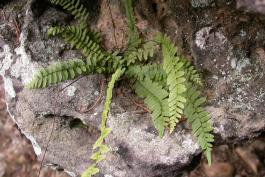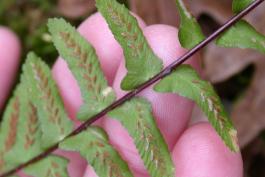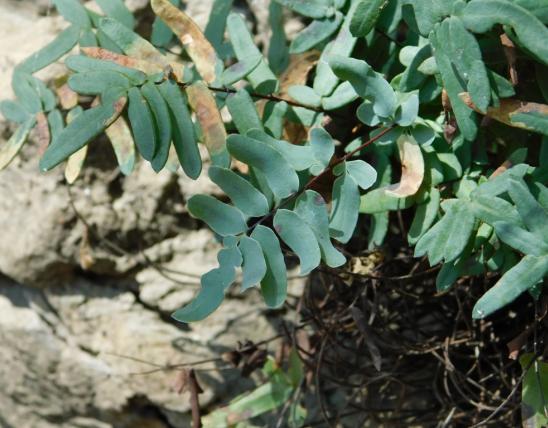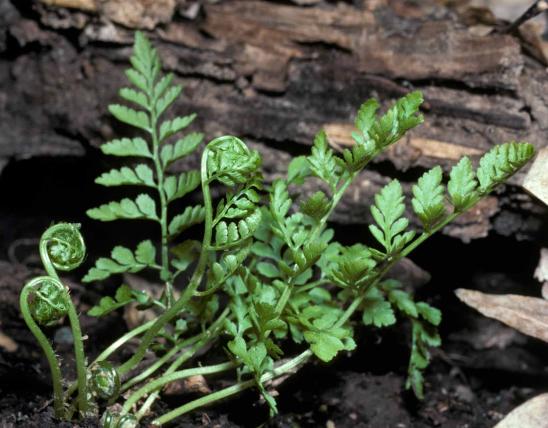
Ebony spleenwort is a perennial fern bearing clusters of leaves. The leaves are 1-time pinnately (feather) compound, linear to narrowly oblong in overall outline, and are dimorphic (there are two forms): The vegetative (sterile) leaves are shorter, lie prostrate on the ground or are arching, have shorter leaflets, and are evergreen. The fertile (spore-bearing) leaves are longer, stand erect, have longer leaflets, and are deciduous (the leaflets fall off in winter). The shiny, wiry leaf stems are reddish brown to dark brown their entire length (to nearly the very tip of the leaf). The leaflets are mostly alternate, shallowly (sometimes deeply) toothed, and eared at the base of the upper margin. The bases of the leaflets overlap the main stalk. Spores are produced May–September.
Similar species: There are 7 additional spleenwort (Asplenium) species in Missouri. Six of these are fernlike and could possibly be confused with ebony spleenwort, while the eighth is walking fern (A. rhizophyllum), which looks very different. Also, Asplenium species are famous for interbreeding and creating hybrids that look like a blend of their parents, so identifying the various species and their hybrid offspring can be challenging even for specialists.
- Little ebony (or blackstem) spleenwort (A. resiliens) has monomorphic leaves (they all take the same form), and the leaflets are mostly opposite. Its leaves only reach about 1 foot in length, and the leaf stems are black instead of brown. It lives mostly in the Ozarks, in shaded crevices of limestone or dolomite bluffs and boulders.
- Interestingly, though it looks very different, walking fern (A. rhizophyllum) can hybridize with ebony spleenwort, where its boulder-and-bluff habitat occurs near the forest-soil habitat of ebony spleenwort. The resulting sterile hybrid is called Scott’s spleenwort (A. x ebenoides). The lower halves of its leaves are much like typical ferns — pinnately compound (feather-compound) — but with the leaflets and lobes irregular in size. In the upper half, however, the leaves are uncut, resembling the leaf tips of walking fern, and sometimes taking root at the tips. The leaf stalks are shiny and reddish brown to dark brown.
- Sometimes, Scott’s spleenwort can bear leaves that are mostly lobed, and in a regular pattern. These can resemble lobed spleenwort (A. pinnatifidum), an uncommon eastern Ozark species whose leaves are shaped overall like those of walking fern, but are deeply lobed yet not truly compound. Lobed spleenwort’s petioles are brown at the base, and dull green above (not shiny).
- Missouri’s other spleenworts include Bradley’s spleenwort (A. bradleyi), mountain spleenwort (A. montanum), wall-rue (A. ruta-muraria), and maidenhair spleenwort (A. trichomanes ssp. trichomanes). Elsewhere, ebony spleenwort has been known to hybridize with lobed spleenwort, wall-rue, and maidenhair spleenwort and also to create backcrosses with Scott’s spleenwort. These may one day be documented for Missouri, too.
Habitat and Conservation
Life Cycle
Human Connections
The name “spleenwort” arose from an ancient belief that any plant that had a structure shaped like a human body part could be used medicinally to treat ailments for that body part. Although that idea is now disproven, people once took the notion very seriously. And because the spore clusters of Asplenium species were spleen-shaped, people thought these plants might heal diseases of the spleen. “Wort,” used in many plant names, is an old word for “herb.”
Asplenium species occur worldwide. Missouri’s spleenworts all belong to a subgroup called the “Appalachian Asplenium Complex,” which is one of the most intensively studied groups of ferns in the world.
Ebony spleenwort can be grown in rock gardens, native plant gardens, or woodland landscapes, but it needs well-drained, rather dry, rocky, shaded places. Always get your native plants from reputable sources, or learn to propagate them yourself. Please do not dig plants from the wild.
Ecosystem Connections
Botanists have noted that spleenworts very commonly form hybrids with each other. Then, the first-generation, sterile hybrids can sometimes regain fertility through a process of chromosome doubling. For example, the fertile species called lobed spleenwort (A. pinnatifidum) originally started long ago as a hybrid between walking fern (A. rhizophyllum) and mountain spleenwort (A. montanum).
Ebony spleenwort has several characteristics that make it a fairly good colonizer of disturbed landscapes. For a fern, it succeeds in a rather wide range of soil pH and light and (well-drained) moisture levels. Its gametophytes can successfully self-fertilize (not requiring cross-fertilizing with gametophytes from other plants). The upraised fertile stalks help the spores to travel far by wind. It develops leaves quickly in spring, helping it compete with other plants. Finally, special “proliferative” buds allow it to reproduce vegetatively, via clones.










































